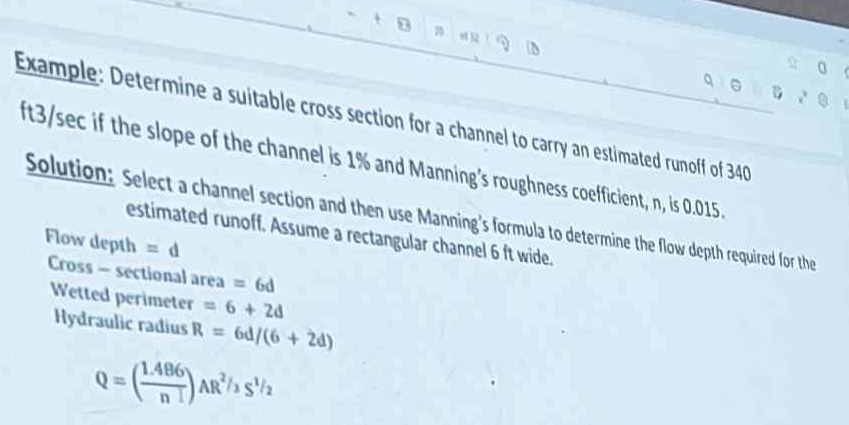Determine a suitable cross section for a channel to carry an estimated runoff of 340 ft3/sec if the slope of the channel is 1% and Manning's roughness coefficient, n, is 0.015. Sel... Determine a suitable cross section for a channel to carry an estimated runoff of 340 ft3/sec if the slope of the channel is 1% and Manning's roughness coefficient, n, is 0.015. Select a channel section and then use Manning's formula to determine the flow depth required for the estimated runoff. Assume a rectangular channel 6 ft wide.

Understand the Problem
The problem involves determining a suitable cross-section for a channel to carry a specific runoff, given the channel's slope, Manning's roughness coefficient, and assuming a rectangular channel shape. You are given the flow depth, cross-sectional area, wetted perimeter, hydraulic radius, and the Manning's formula, and you will need to find the flow depth d using these equations.
Answer
$d \approx 4 \text{ ft}$
Answer for screen readers
$d \approx 4 \text{ ft}$
Steps to Solve
- State Manning's Formula
Manning's formula is given as: $Q = (\frac{1.486}{n}) AR^{2/3}S^{1/2}$
- Substitute known variables
We are given $Q = 340 \text{ ft}^3/\text{sec}$, $n = 0.015$, $S = 1% = 0.01$.
- Substitute geometric relationships
We also have $A = 6d$ and $R = \frac{6d}{6+2d}$. Substitute these into Manning's formula:
$340 = (\frac{1.486}{0.015}) (6d) (\frac{6d}{6+2d})^{2/3} (0.01)^{1/2}$
- Simplify the equation
Simplify the constants: $340 = (99.067) (6d) (\frac{6d}{6+2d})^{2/3} (0.1)$ $340 = 9.9067 (6d) (\frac{6d}{6+2d})^{2/3}$ $340 = 59.44 d (\frac{6d}{6+2d})^{2/3}$
- Isolate the term with 'd'
Divide both sides by $59.44$:
$\frac{340}{59.44} = d (\frac{6d}{6+2d})^{2/3}$ $5.72 = d (\frac{6d}{6+2d})^{2/3}$
- Solve for d
This equation is difficult to solve analytically, so we can use numerical methods or trial and error to find the value of $d$. By inspection, we can try different values of $d$.
Let's try $d=3$: $3 (\frac{6(3)}{6+2(3)})^{2/3} = 3 (\frac{18}{12})^{2/3} = 3 (1.5)^{2/3} = 3 * 1.31 = 3.93 \neq 5.72 $
Now, let's try $d=4$: $4 (\frac{6(4)}{6+2(4)})^{2/3} = 4 (\frac{24}{14})^{2/3} = 4 (1.714)^{2/3} = 4 * 1.43 = 5.72 $
Therefore, by trial and error, $d \approx 4 \text{ ft}$.
$d \approx 4 \text{ ft}$
More Information
The flow depth $d$ is approximately 4 feet for the given conditions.
Tips
- Not converting the slope from percentage to a decimal.
- Incorrectly substituting the given values into Manning's formula.
- Making algebraic errors while simplifying the equation.
- Difficulty in solving the resulting equation for 'd', often requiring numerical methods or approximation.
AI-generated content may contain errors. Please verify critical information